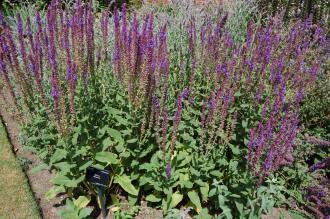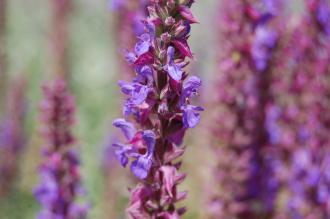
Salvia deserta (18/07/15, Kew Gardens, London)
Position: Full sun to light shade
Flowering period: Summer
Soil: Moist, well drained
Eventual Height: 70cm
Eventual Spread: 50cm
Hardiness: 4a, 4b, 5a, 5b, 6a, 6b, 7a, 7b, 8a, 8b
Family: Lamiaceae
Salvia deserta is a deciduous herbaceous perennial with an erect, clump forming habit. Its dark green leaves are ovate to lanceolate with scalloped margins, up to 9cm long and 5cm across. Its blue/ purple flowers appear in terminal racemes and are up to 10cm long.

Salvia deserta Flower (18/07/15, Kew Gardens, London)
Salvia deserta, commonly known as Meadow Sage, is native to east China, Kazakhstan and Kyrgyzstan. In its native habitat it grows in sandy grassland and along streams in forests.
The etymological root of the binomial name Salvia is derived from the Latin salvare, meaning to ‘save’ or ‘heal’, in reference to its historical use as a medicinal plant. Deserta is from the Latin meaning ‘of deserts’.

Salvia deserta Leaf (18/07/15, Kew Gardens, London)
When available the landscape architect may find Salvia deserta useful in low maintenance, prairie type schemes. It is also useful in wildlife gardens due to its attractiveness to insects. Once established this plant is drought tolerant.
Ecologically, Salvia deserta flowers are attractive to pollinating insects, including bees.
Salvia deserta prefers moist, fertile, well-drained soils. It tolerates most pH of soil.
Salvia deserta requires little maintenance. After flowering the flower heads may be removed to encourage a second flush of flowers. Large clumps may be divided in spring or autumn.

Landscape Architecture

